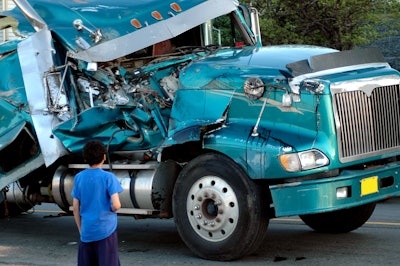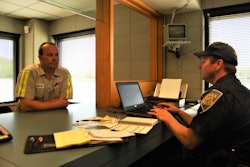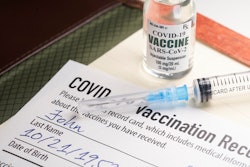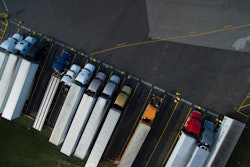
Trucking companies more often than not are on the losing end of a court battle, leading to exponential growth in courts awarding plaintiffs significant amounts of money following crashes involving commercial trucks.
According to a study from the American Transportation Research Institute, the average size of crash-related verdicts – also known as nuclear verdicts – has increased by nearly 1,000% since 2010, and the number of cases between 2012 and 2019 grew by 335% compared to the previous six years.
It's a trend that’s causing smaller fleets to shut down or at the very least leaving fleets underinsured as the rise in nuclear verdicts spur increases in insurance costs.
But the experts have some tips to help fleets combat nuclear verdicts, and they say it starts with data.
“What can we do to now start to fight back and start to be able to combat a lot of these rising costs and a lot of these rising claims? … I think that really first starts with an understanding of your own data because that's where the plaintiff's attorneys obviously start,” said Idelic Founder and Chief Innovation Officer Hayden Cardiff during the Truckload Carriers Association’s recent webinar Preventing Nuclear Verdicts: Going on Offense Against Your Liability.
He said while there are larger, systematic things that can be done like tort reform, the best way for fleets to fight nuclear verdicts is to understand what plaintiffs attorneys look for in any given case and to be proactive in safety and operations management to eliminate risk.
Brandon Guiliani, transportation practice leader and principal at Seubert & Associates Inc. said attorneys are looking beyond the facts of a crash to fleet practices to establish negligence.
“Historically, we've always thought if I can make sure my driver is compliant and my driver has done the things that he or she needs to do that I'm covered,” Guiliani said. “But … there's been a shift, and that shift is … moving the conversation away from the driver and moving towards the fleet.”
He said plaintiffs attorneys are digging into what fleets are doing corporate wide, and being compliant isn’t enough anymore to defend your company in court.
Much of a company’s operations will come under the microscope. Cardiff said that includes driver hiring, onboarding and retention standards, training, compliance and safety measures, driver turnover and engagement, communications among departments, data from electronic logging devices and video evidence from cameras, numbers of accidents and worker’s comp claims, driver performance management, background of each individual driver, handbook adherence and escalation process continuity, number of safety and compliance staff and company culture, among many other things.
“We've got data coming out of our ears at this point,” Cardiff said. “… All of that is discoverable, so if you're not looking at it beforehand, you will definitely be defending it after the fact when you're in court.”
Guiliani said fleets need to tackle their level of liability and improve risk by addressing those issues before a crash occurs.
And it starts with the drivers, he said.
He said companies should talk to their drivers to learn what issues they’re experiencing and pinpoint the drivers that need additional training and award those who are meeting productivity and safety standards.
Cardiff said operationalizing safety – aligning operations teams and safety teams to push in the same direction and own the same metrics – is a hot-button issue but something that is necessary to improve safety and win in a litigious environment. To do that, he said companies can evaluate their operations team members’ performance based on the drivers under their purview.
“It really comes down to driver performance management, making sure … you're operationalizing safety, you're going in and making sure that all of the professional development plans and coaching across the board can be dialed in, documented and understood, integrating and consolidating the data to give you that visualization of the drivers’ performance,” Cardiff said. “Once you do that, you can start to identify those areas – both from a process as a fleet and down at the end of the driver level – where you can step in and start to make a good impact and rooting out that liability.”
Guiliani said going beyond compliance and taking these extra steps can help a trucking company keep its doors open.
Though the nuclear verdict trend goes beyond the trucking industry, he said the dollar amounts of such awards are much higher in trucking and only getting larger. One, he said, was a $1 billion verdict in Florida last year.
Cardiff said the increase in nuclear verdict cases has drawn the attention of insurance carriers, and it is changing industry standards.
“The industry standard has been raised. If you have an ELD, you should have a camera. That technology is available,” Cardiff said. “I don't know if there's going to be any(thing) legal like the Federal Motor Carrier Safety Administration requiring ELDs … but, effectively, I think it will get mandated by the insurance carriers and saying that if you don't have this technology, you're uninsurable.”
Guiliani said that’s because insurers haven’t turned a profit in nearly 12 years because of litigation – and it’s causing insurance rates to rise. He said insurance companies will also dig into a company’s data like plaintiffs attorneys to determine the risk of insuring a fleet and a fleet’s tier of pricing, furthering the need to be more proactive in nuclear verdict prevention by operationalizing safety and working with drivers.
“Driver retention, driver shortage, nuclear verdicts, insurance costs rising – all of those are tied together, and they're all tied to a need to improve driver performance management,” Cardiff said.











